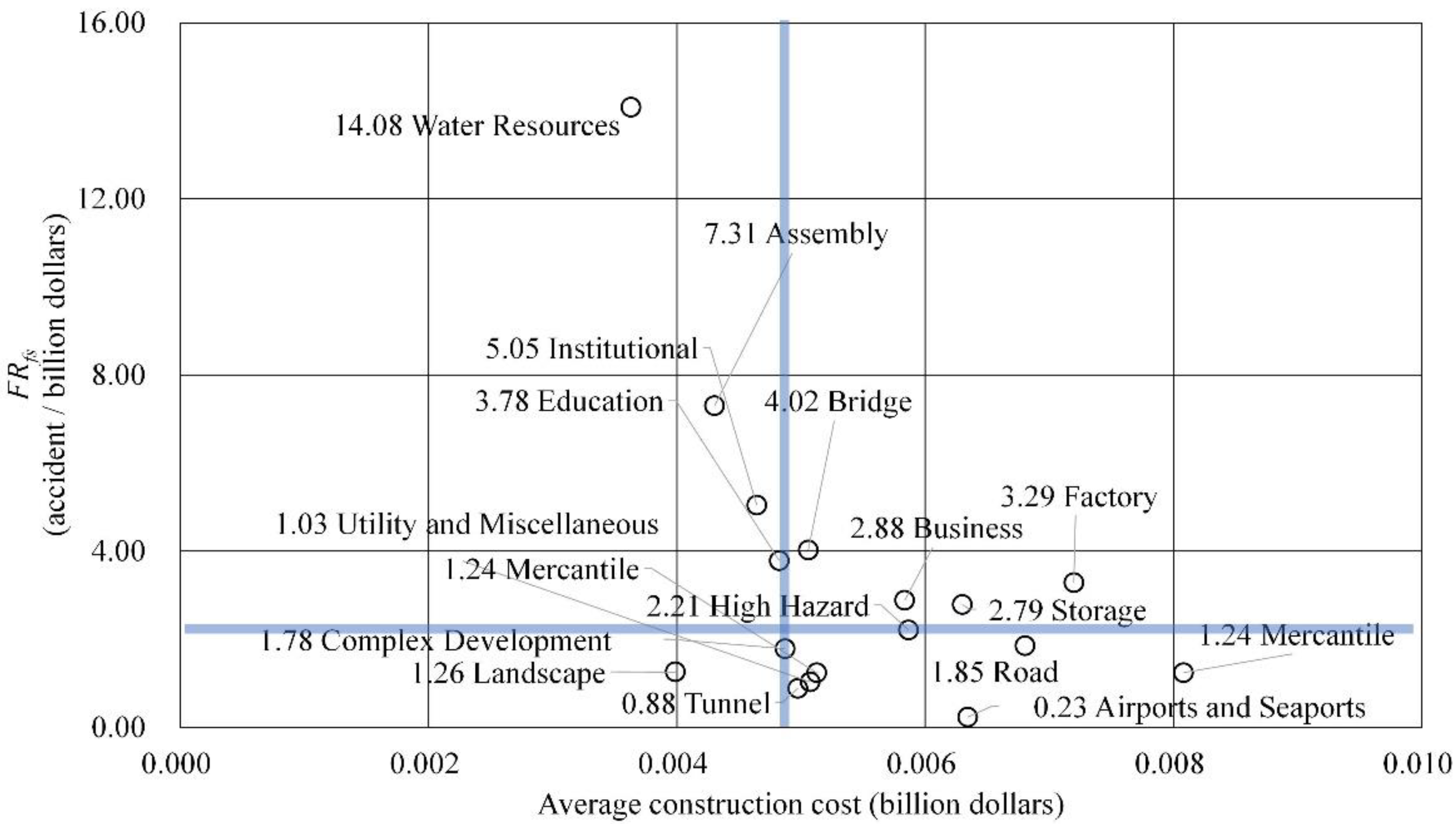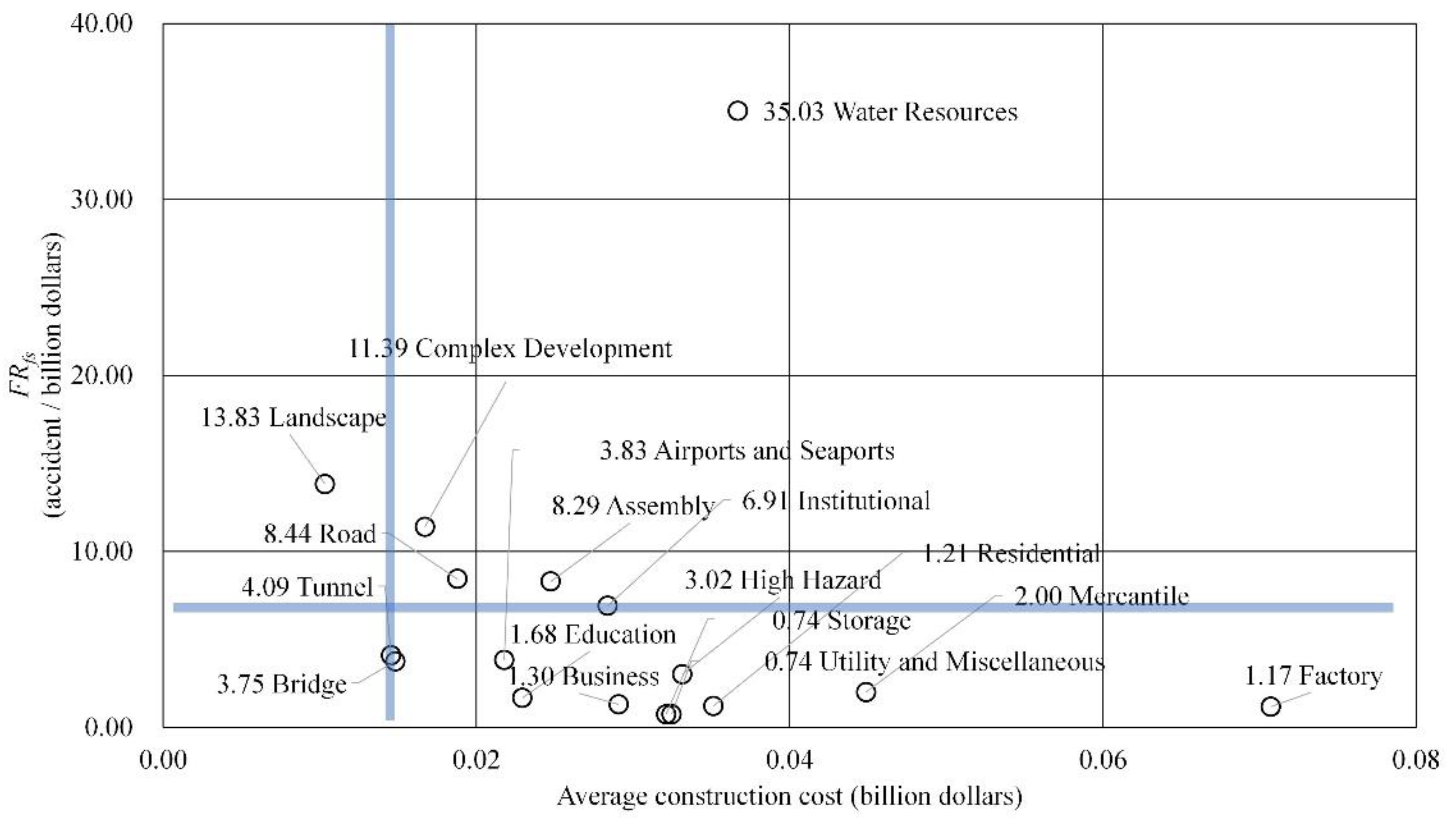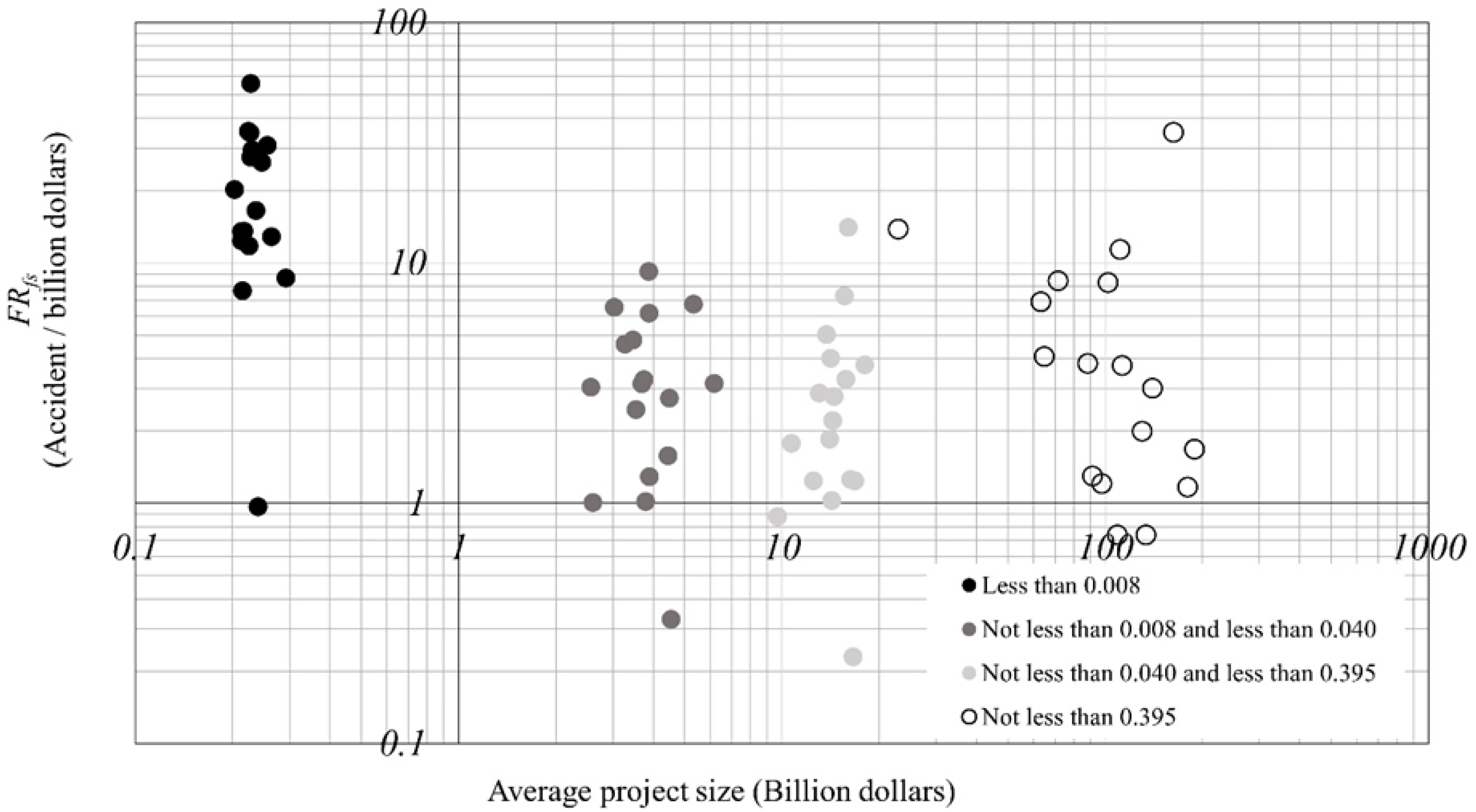Evaluation of Accident Risk Level Based on Construction Cost, Size and Facility Type
Abstract
1. Introduction
2. Literature Review
3. Materials and Methods
3.1. Data Collection and Classification
(Monthly wage of construction worker × 12 × The number of workers)/(Ratio of the labor cost to revenue)
3.2. Evaluation of Risk Level According to Facility Type
(The number of fatal accidents)/(The number of construction workers) × 10,000
(Annual construction revenue × Ratio of the labor cost to revenue)/(Monthly wage of construction worker × 12)
3.3. Evaluation of Risk Level for Each Facility Type according to Project Size Based on Total Cost
4. Results and Discussion
4.1. Analysis of Number of Fatal Accidents and Fatality Rate for Each Facility Type
4.1.1. Analysis of FRfs for Size 1 Construction Site
4.1.2. Analysis of FRfs for Size 2 Construction Site
4.1.3. Analysis of FRfs for Size 3 Construction Site
4.1.4. Analysis of FRfs for Size 4 Construction Site
4.2. Discussion
- (1)
- The “Assembly” facility type typically includes facilities such as art museums, churches, and performance halls. For the construction of facilities such as museums, there are many long-span structures, so consideration should also be given to heavy objects and the safety evaluation of floor vibrations [25]. In the case of “Assembly” facilities, fall accidents were the main cause of fatal accidents. Therefore, safety management measures should be taken through the smooth coordination of opinions between field workers and safety managers to determine risk factors of falling accidents.
- (2)
- “Institutional” facilities typically include hospitals and prisons. In the case of hospital construction, the design is complicated and diverse owing to not only the functional elements of the building, but also the space planning of the patient-first, natural environmental building arrangement, as well as the creation of a healing environment. Therefore, it is necessary to continuously improve and manage hospital construction, where various types of work and operations are complicated, by blocking risks in advance through thorough risk factor analysis and systematic safety management activities, and by implementing appropriate countermeasures [25,26].
- (3)
- “High Hazard” refers to facilities that store hazardous substances, such as petrochemical plants. These projects have potential risks such as fire, explosion, and leakage, and require a high-level safety management system. However, there is no appropriate qualification standard, and it is conducted arbitrarily by the company. Therefore, it is necessary to institutionalize the registration standards for the design and supervision in relation to the installation of hazardous material facilities. In addition, as the chemical process becomes more complex owing to developments in the industry, there is an increased amount of risk in handling hazardous substances along with an increased uncertainty of accidents [27].
- (4)
- In the case of “Factory”, internal facilities and equipment occupy a larger proportion compared with general buildings, and the composition is complicated. In the case of the high-tech industry, the standardization and systematization of the construction information classification system for high-tech factory construction is very low. This is owing to problems such as the difficulty in classifying the scale, the variety of types of work, the complexity of construction, and security. Therefore, it is necessary to collect and analyze data on factory design [28].
- (5)
- In the case of “Water Resources”, projects are largely carried out in the form of river environment maintenance projects, flood restoration projects, and projects for flood prevention. Consequently, the rate of traffic accidents caused by large equipment such as crushed soil or concrete vehicles was higher than that of other facilities [29]. Therefore, it is necessary to secure a route to prevent soil collapse and prevent traffic accidents during construction.
- (6)
- In the case of “Landscape”, the design of the finished construction is decided prior to the construction, but the design is frequently changed owing to pressure during the construction period and the different drawing conditions of the site. For this reason, “Landscape” facilities were found to be facilities with a high-risk level owing to poor construction quality [30]. As landscaping construction involves large-scale movement of materials, it is considered that a safe working environment can be created only when there is clear communication during design changes.
- (7)
- In the case of “Complex Development”, the rate of traffic accidents is higher than that of other facilities due to the large scale of the construction, the large amount of manpower, and the use of large-scale equipment [30]. In addition, in the case of development for the establishment of an industrial complex, it is necessary to consider the presence of buried pipes and gas pipes, so it is necessary to ensure safety by addressing these specific issues in advance.
5. Conclusions
- (i)
- Unlike the manufacturing industry, where the number of laborers is fixed, the number of laborers in a construction site is unclear, and the appointment of a safety manager and the cost of safety management are all determined by the construction price. Therefore, for accurate numerical analysis, the cost-based probability evaluation presented in this paper is necessary.
- (ii)
- The risk level was calculated by considering the type of facility in consideration of the proportion of labor costs that vary depending on the type of construction work and the corresponding level of labor risk. As a result, in general, in small-scale construction, more safety costs should be invested in construction work, and in the case of landscape, more safety costs should be invested in large-scale construction.
- (iii)
- Since the subject of applicable laws differs depending on the scale of construction work, the risk level is evaluated by dividing into four widely used sizes to provide indicators to evaluate whether appropriate laws are being applied for each section.
Author Contributions
Funding
Institutional Review Board Statement
Informed Consent Statement
Data Availability Statement
Conflicts of Interest
References
- Lee, J.; Jeong, J.; Soh, J.; Jeong, J. Development of framework for estimating fatality-related losses in the Korean construction industry. Int. J. Environ. Res. Public Health 2021, 18, 8787. [Google Scholar] [CrossRef] [PubMed]
- A Report on Industrial Accidents in 2020; Ministry of Employment and Labor: Seoul, Republic of Korea, 2021.
- Dong, X.S.; Choi, S.D.; Borchardt, J.G.; Wang, X.; Largay, J.A. Fatal falls from roofs among US construction workers. J. Saf. Res. 2013, 44, 17–24. [Google Scholar] [CrossRef] [PubMed]
- Aven, T.; Zio, E. Some considerations on the treatment of uncertainties in risk assessment for practical decision making. Reliab. Eng. Syst. Saf. 2011, 96, 64–74. [Google Scholar] [CrossRef]
- Kim, J.H. A study on the rationalization of safety management through the analysis of accident cause and occurrence principles for safety accidents in the construction industry-focused on burial, conflagration, explosion, burn. J. Korea Inst. Build. Constr. 2010, 10, 99–111. [Google Scholar] [CrossRef]
- Jeong, J.; Jeong, J. Quantitative risk evaluation of fatal incidents in construction based on frequency and probability analysis. J. Manag. Eng. 2022, 38, 04021089. [Google Scholar] [CrossRef]
- Jang, Y.R.; Go, S.S. A risk assessment counterplan for reducing the accident rates in medium and small sized construction sites. Korean J. Constr. Eng. Manag. 2018, 19, 90–100. [Google Scholar]
- Jeong, J.; Jeong, J. Novel approach of the integrated work & risk breakdown structure for identifying the hierarchy of fatal incident in construction industry. J. Build. Eng. 2021, 41, 102406. [Google Scholar]
- Choi, S.D.; Guo, L.; Kim, J.; Xiong, S. Comparison of fatal occupational injuries in construction industry in the United States, South Korea, and China. Int. J. Ind. Ergon. 2019, 71, 64–74. [Google Scholar] [CrossRef]
- Pham, K.T.; Vu, D.N.; Hong, P.L.H.; Park, C. 4D-BIM-based workspace planning for temporary safety facilities in construction SMEs. Int. J. Environ. Res. Public Health 2020, 17, 3403. [Google Scholar] [CrossRef]
- Baloi, D.; Price, A.D. Modelling global risk factors affecting construction cost performance. Int. J. Proj. Manag. 2003, 21, 261–269. [Google Scholar] [CrossRef]
- Chua, D.K.; Goh, Y.M. Poisson model of construction incident occurrence. J. Constr. Eng. Manag. 2005, 131, 715–722. [Google Scholar] [CrossRef]
- Kim, H.M.; Woo, I.S. A study of methods on risk assessment for plant construction using FMEA (failure mode and effect analysis). J. Korean Soc. Saf. 2013, 28, 81–90. [Google Scholar] [CrossRef]
- Park, J.; Paek, S. Development of safety management information system for construction works, focusing on tunnel construction. J. Korean Soc. Disaster Secur. 2008, 23, 72–78. [Google Scholar]
- Park, J.K. A development on the safety management information system in building work. J. Korean Soc. Saf. 2005, 20, 71–77. [Google Scholar]
- Gurcanli; Emre, G.; Bilir, S.; Sevim, M. Activity based risk assessment and safety cost estimation for residential building construction projects. Saf. Sci. 2015, 80, 1–12. [Google Scholar] [CrossRef]
- Cho, Y.R.; Shin, Y.S.; Shin, J.K. Checklist development for prevention of safety accidents in form work in small and medium sized construction sites. J. Korea Inst. Build. Constr. 2017, 17, 587–594. [Google Scholar]
- Tymvios, N.; Gambatese, J.A. Perceptions about design for construction worker safety: Viewpoints from contractors, designers, and university facility owners. J. Constr. Eng. Manag. 2016, 142, 04015078. [Google Scholar] [CrossRef]
- Lee, K. Analysis of the adequacy of the safety manager appointment system by comparing the cost-effectiveness of disaster prevention by construction site size. J. Korea Inst. Build. Construction 2008, 24, 161–168. [Google Scholar]
- A Report on Construction Industrial Fatal Accidents on Total Project Cost from 2013 to 2019; Korean Statistical Information Service: Seoul, Republic of Korea, 2021.
- Edward, A.; Iano, J. Fundamentals of Building Construction: Materials and Methods; Wiley: Hoboken, NJ, USA, 2019. [Google Scholar]
- LABOR STANDARDS ACT; Ministry of Employment and Labor: Seoul, Republic of Korea, 2018.
- A Report on Monthly Wage of Construction Cost & Ratio of the Labor Cost to Revenue; Ministry of Employment and Labor: Seoul, Republic of Korea, 2021.
- Son, S. Evaluation of Probability of Accident Based on the Number of Workers and Construction Cost by Work Types and Effect of Safety Patrol Team Operation in Residential Construction Projects. Master’s Thesis, Seoul National University of Science and Technology, Seoul, Republic of Korea, 2022. [Google Scholar]
- Pauget, B.; Wald, A. Relational competence in complex temporary organizations: The case of a French hospital construction project network. Int. J. Proj. Manag. 2013, 31, 200–211. [Google Scholar] [CrossRef]
- Pyo, B.; Pang, M. A study of risk factors and safety measures in hospital construction. In Proceedings of the Korean Safety Management & Science Conference, Seoul, Republic of Korea, 21 April 2012; pp. 197–204. [Google Scholar]
- Choi, S.-H.; Kim, J.-C.; Kwon, S.-W. Establishment of WBS·CBS-based construction information classification system for efficient construction cost analysis and prediction of high-tech factories. J. Korea Contents Assoc. 2021, 21, 356–366. [Google Scholar]
- Bouafia, A.; Bougofa, M.; Rouainia, M.; Medjram, M.S. Safety risk analysis and accidents modeling of a major gasoline release in petrochemical plant. J. Fail. Anal. Prev. 2020, 20, 358–369. [Google Scholar] [CrossRef]
- Jang, C.-R.; Jang, M.-Y.; Song, J.-J.; Kim, H.-T. A Study on the Re-establishment of the River Construction Work Breakdown Structure and the Computerization Measures of the Completion Results for the Development of the River Construction Management System. J. Korea Acad.-Ind. Coop. Soc. 2021, 22, 663–672. [Google Scholar]
- Park, J.Y.; Jo, S.-H. Expert perception analysis on the feasibility of planting design change in private enterprise landscaping construction. J. Korean Inst. Landsc. Archit. 2014, 42, 101–110. [Google Scholar] [CrossRef]






| Note | Authors | Contents | Results |
|---|---|---|---|
| Fatality rate |
|
| |
| Facility type |
|
| |
| Construction scale |
|
|
| Number | Facility Type |
|---|---|
| 1 | Assembly |
| 2 | Business |
| 3 | Education |
| 4 | Factory |
| 5 | High Hazard |
| 6 | Institutional |
| 7 | Mercantile |
| 8 | Residential |
| 9 | Storage |
| 10 | Utility and Miscellaneous |
| 11 | Road |
| 12 | Bridge |
| 13 | Airports and Seaports |
| 14 | Tunnel |
| 15 | Complex Development |
| 16 | Water Resources |
| 17 | Landscape |
| Number | Scale of the Construction |
|---|---|
| 1 | Less than 5 construction workers |
| 2 | Not less than 5 and less than 30 construction workers |
| 3 | Not less than 30 and less than 300 construction workers |
| 4 | Not less than 300 construction workers |
| Size Number | Project Size Based on Total Cost (Billion Dollars) |
|---|---|
| Size 1 | Less than 0.008 |
| Size 2 | Not less than 0.008 and less than 0.040 |
| Size 3 | Not less than 0.040 and less than 0.395 |
| Size 4 | Not less than 0.395 |
| Size Number | Residential (from 2013 to 2019) | |
|---|---|---|
| Number of Fatal Accidents (Accident) | Total Project Cost (Billion Dollars) | |
| Size 1 | 361 | 19.35 |
| Size 2 | 107 | 32.59 |
| Size 3 | 137 | 110.44 |
| Size 4 | 224 | 184.57 |
| Number | Facility Type | Number of Fatal Accidents | Construction Cost (Billion Dollars) | Rank |
|---|---|---|---|---|
| 1 | Assembly | 220 | 14.62 | 6 |
| 2 | Business | 384 | 79.71 | 3 |
| 3 | Education | 108 | 19.82 | 10 |
| 4 | Factory | 720 | 139.17 | 2 |
| 5 | High Hazard | 92 | 16.39 | 12 |
| 6 | Institutional | 77 | 9.32 | 13 |
| 7 | Mercantile | 194 | 36.21 | 8 |
| 8 | Residential | 829 | 346.96 | 1 |
| 9 | Storage | 119 | 17.53 | 9 |
| 10 | Utility and Miscellaneous | 250 | 60.38 | 5 |
| 11 | Road | 285 | 63.00 | 4 |
| 12 | Bridge | 35 | 8.37 | 15 |
| 13 | Airports and Seaports | 6 | 9.44 | 17 |
| 14 | Tunnel | 22 | 10.15 | 16 |
| 15 | Complex Development | 94 | 24.11 | 11 |
| 16 | Water Resources | 207 | 25.20 | 7 |
| 17 | Landscape | 45 | 16.36 | 14 |
| Number | Facility Type | FRf (Accidents/Billion Dollars) | Rank |
|---|---|---|---|
| 1 | Assembly | 15.05 | 1 |
| 2 | Business | 4.82 | 9 |
| 3 | Education | 5.45 | 6 |
| 4 | Factory | 5.17 | 8 |
| 5 | High Hazard | 5.61 | 5 |
| 6 | Institutional | 8.26 | 2 |
| 7 | Mercantile | 5.36 | 7 |
| 8 | Residential | 2.39 | 15 |
| 9 | Storage | 6.79 | 4 |
| 10 | Utility and Miscellaneous | 4.14 | 12 |
| 11 | Road | 4.52 | 10 |
| 12 | Bridge | 4.18 | 11 |
| 13 | Airports and Seaports | 0.64 | 17 |
| 14 | Tunnel | 2.17 | 16 |
| 15 | Complex Development | 3.90 | 13 |
| 16 | Water Resources | 8.21 | 3 |
| 17 | Landscape | 2.75 | 14 |
| Number | Facility Type | FRfs | Rank |
|---|---|---|---|
| 1 | Assembly | 55.81 | 1 |
| 2 | Business | 27.57 | 6 |
| 3 | Education | 16.52 | 10 |
| 4 | Factory | 26.28 | 7 |
| 5 | High Hazard | 34.92 | 3 |
| 6 | Institutional | 35.31 | 2 |
| 7 | Mercantile | 30.84 | 4 |
| 8 | Residential | 8.66 | 9 |
| 9 | Storage | 29.56 | 5 |
| 10 | Utility and Miscellaneous | 12.38 | 14 |
| 11 | Road | 13.52 | 12 |
| 12 | Bridge | 11.76 | 15 |
| 13 | Airports and Seaports | 0.97 | 17 |
| 14 | Tunnel | 20.26 | 8 |
| 15 | Complex Development | 13.59 | 11 |
| 16 | Water Resources | 12.86 | 13 |
| 17 | Landscape | 7.66 | 16 |
| Number | Facility Type | FRfs | Rank |
|---|---|---|---|
| 1 | Assembly | 9.22 | 1 |
| 2 | Business | 4.78 | 5 |
| 3 | Education | 2.74 | 11 |
| 4 | Factory | 6.74 | 2 |
| 5 | High Hazard | 4.60 | 6 |
| 6 | Institutional | 6.55 | 3 |
| 7 | Mercantile | 2.46 | 12 |
| 8 | Residential | 3.28 | 7 |
| 9 | Storage | 6.20 | 4 |
| 10 | Utility and Miscellaneous | 1.58 | 13 |
| 11 | Road | 3.15 | 9 |
| 12 | Bridge | 1.29 | 14 |
| 13 | Airports and Seaports | 0.33 | 17 |
| 14 | Tunnel | 1.01 | 16 |
| 15 | Complex Development | 3.05 | 10 |
| 16 | Water Resources | 3.16 | 8 |
| 17 | Landscape | 1.02 | 15 |
| Number | Facility Type | FRfs | Rank |
|---|---|---|---|
| 1 | Assembly | 7.31 | 2 |
| 2 | Business | 2.88 | 7 |
| 3 | Education | 3.78 | 5 |
| 4 | Factory | 3.29 | 6 |
| 5 | High Hazard | 2.21 | 9 |
| 6 | Institutional | 5.05 | 3 |
| 7 | Mercantile | 1.24 | 14 |
| 8 | Residential | 1.24 | 13 |
| 9 | Storage | 2.79 | 8 |
| 10 | Utility and Miscellaneous | 1.03 | 15 |
| 11 | Road | 1.85 | 10 |
| 12 | Bridge | 4.02 | 4 |
| 13 | Airports and Seaports | 0.23 | 17 |
| 14 | Tunnel | 0.88 | 16 |
| 15 | Complex Development | 1.78 | 11 |
| 16 | Water Resources | 14.08 | 1 |
| 17 | Landscape | 1.26 | 12 |
| Number | Facility Type | FRfs | Rank |
|---|---|---|---|
| 1 | Assembly | 8.29 | 5 |
| 2 | Business | 1.30 | 13 |
| 3 | Education | 1.68 | 12 |
| 4 | Factory | 1.17 | 15 |
| 5 | High Hazard | 3.02 | 10 |
| 6 | Institutional | 6.91 | 6 |
| 7 | Mercantile | 2.00 | 11 |
| 8 | Residential | 1.21 | 14 |
| 9 | Storage | 0.74 | 16 |
| 10 | Utility and Miscellaneous | 0.74 | 17 |
| 11 | Road | 8.44 | 4 |
| 12 | Bridge | 3.75 | 9 |
| 13 | Airports and Seaports | 3.83 | 8 |
| 14 | Tunnel | 4.09 | 7 |
| 15 | Complex Development | 11.39 | 3 |
| 16 | Water Resources | 35.03 | 1 |
| 17 | Landscape | 13.83 | 2 |
Disclaimer/Publisher’s Note: The statements, opinions and data contained in all publications are solely those of the individual author(s) and contributor(s) and not of MDPI and/or the editor(s). MDPI and/or the editor(s) disclaim responsibility for any injury to people or property resulting from any ideas, methods, instructions or products referred to in the content. |
© 2023 by the authors. Licensee MDPI, Basel, Switzerland. This article is an open access article distributed under the terms and conditions of the Creative Commons Attribution (CC BY) license (https://creativecommons.org/licenses/by/4.0/).
Share and Cite
Bang, S.; Jeong, J.; Lee, J.; Jeong, J.; Soh, J. Evaluation of Accident Risk Level Based on Construction Cost, Size and Facility Type. Sustainability 2023, 15, 1565. https://doi.org/10.3390/su15021565
Bang S, Jeong J, Lee J, Jeong J, Soh J. Evaluation of Accident Risk Level Based on Construction Cost, Size and Facility Type. Sustainability. 2023; 15(2):1565. https://doi.org/10.3390/su15021565
Chicago/Turabian StyleBang, Saemi, Jaewook Jeong, Jaehyun Lee, Jaemin Jeong, and Jayho Soh. 2023. "Evaluation of Accident Risk Level Based on Construction Cost, Size and Facility Type" Sustainability 15, no. 2: 1565. https://doi.org/10.3390/su15021565
APA StyleBang, S., Jeong, J., Lee, J., Jeong, J., & Soh, J. (2023). Evaluation of Accident Risk Level Based on Construction Cost, Size and Facility Type. Sustainability, 15(2), 1565. https://doi.org/10.3390/su15021565










